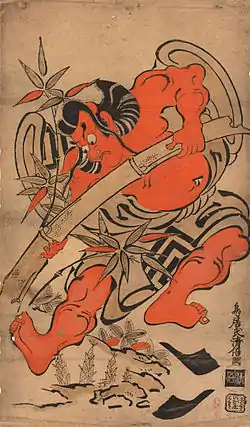Soga Monogatari
Soga Monogatari (曽我物語) is a Japanese monogatari (or gunkimono), the epic tale of two brothers. It was dramatized based on the incident 'Revenge of Soga Brothers'. The story is often known as The (illustrated) Tale of the Soga Brothers or The revenge of the Soga brothers. It is sometimes written as Soga Monogatari Zue (The Tale of the Soga brothers in pictures). It is regarded by some as the last of the Gunki monogatari or great "war tales".
The brothers are Soga Jūrō and Soga Gorō. Jūrō being the older of the two. When the boys were younger they were known as Ichimanmaru and Hakoomaru. In Japanese the Soga brothers are described as Soga kyodai. Their names are also written as Soga no Gorō and Soga no Jūrō. The name Soga is the name of their stepfather, which became their surname after their mother remarried. The name of their biological father was Kawazu-Saburō.
Authorship
The Tale of the Soga Brothers origin cannot be traced to a single creator. Like most of these historical stories, it is the result of the compounding of (often differing) versions passed down through an oral or other tradition. The origin of the story may be true, but the story is probably romanticised. In some versions of the story it is only revealed at the end that the main character is actually one of the brothers.
Plot
Events take place in Japan in the 12th century. The general accepted version is that the father of the two boys was killed (the reasons differ, but it was probably an argument over land rights) when they were infants. As adults they became skilled fighters intent on avenging their father and retrieving his sword Tomokirimaru. The villain is usually Kudō Suketsune, a retainer of the shōgun (probably Minamoto no Yoritomo). Jūrō is killed in the fighting as is Kudō Suketsune. Gorō dies later (by execution).
In popular culture
The story has been the subject of many Noh, kabuki and bunraku performances. There are also updated versions such as Sukeroku (The Flower of Edo) (an 18th century kabuki play, which is regarded as one of the Kabuki Jūhachiban). It is also said that the Soga tales in Kōwakamai are based on this tale.
The story and its performers have been popular subjects for woodblock prints,[1] netsuke[2] and okimono.
The story has also been the subject of a number of films.[3][4]
Notes
In Japan there are many statues of the brothers (such as the famous statue in the Hachiman Jinja in Kawazu, Shizuoka). According to tradition they were buried at the foot of Mount Fuji, there is a sculpture of their tombs among the stone statues in Hakone.[5]
Otodome Falls is one of the locations in a version of the tale from the Kamakura period.
There is no relation with the Soga clan.
Translations
The story was translated by Thomas J. Cogan.[6] This translation was reviewed by Laurence Kominz in the Harvard Journal of Asiatic Studies.[7]
Gallery
 A print of Ichikawa Danjuro I in his role as Soga Gorō.
A print of Ichikawa Danjuro I in his role as Soga Gorō. A print of the Soga brothers practising swordstrokes on a heap of snow.
A print of the Soga brothers practising swordstrokes on a heap of snow. Gorō riding to Ōiso
Gorō riding to Ōiso
References
- The Tale of the Soga brothers by Andō Hiroshige
- An example sold by Christie's in Amsterdam in 2008
- An example of a 1915 film on the IMDb website
- An example of a 1920 film on the IMDb website
- The Stone Statues on the Hakone Tourism Website
- The Tale of the Soga Brothers; Cogan, Thomas J.; University of Tokyo Press; November 18, 1987; Hardcover: 336 pages; ISBN 978-0860084112
- Review in the Harvard Journal of Asiatic Studies on JSTOR
External links
| Wikimedia Commons has media related to The Tale of the Soga. |
- A website dedicated to Samurai culture
- A website dedicated to the stories of Old Japan
- An example of Soga Monogatari Zue by Andō Hiroshige on the British Museum online collection website
- The Tale of the Soga Brothers on the Asian Art Museum website
- The Tale of the Soga Brothers on the Honolulu Museum of Art website